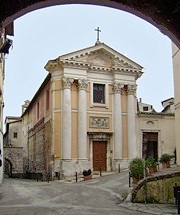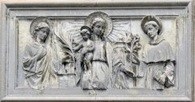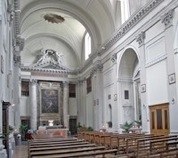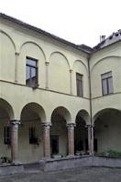



The present church was built in the 12th century, when the street level had risen considerably. This new church extended south beyond its original foundations into what had been the forum, obliterating its original facade and that of the temple. The space under the new apse of the church became the crypt of Sant' Isacco.
A copy (ca. 1580) of a subsequently lost inscription suggests that Pope Alexander III consecrated the new church in 1164. [He was from Siena and this probably explains its original dedication to St Ansanus, a patron saint of that city.] However, the church also had a second dedication to St Isaac: a diploma (1185) from Pope Urban III confirming the possessions of the Benedictine monastery of San Giuliano includes the monastery of St Isaac "in civitate Spoletana". This is the earliest reference to a monastery on the site.
The church and adjoining monastery passed from the Benedictines to the Lateran Canons in 1502. The canons also acquired San Giuliano at this point, but they preferred to live at Sant' Ansano. They translated the relics of St Isaac from San Giuliano to the crypt of Sant' Ansano at that time. By the 17th century, the church had become known as Sant' Ansano while the crypt was known as Sant' Isacco.
The church was remodelled in the neo-Classical style in the late 18th century.
-
✴The complex remained in the possession of the Lateran canons until 1826.
-
✴It then passed to the Congregation of the Most Holy Redeemer, a society of missionary priests that had been founded by St. Alphonsus Maria Liguori in 1732.
-
✴It housed the Benedictine nuns from Sant’ Agata from 1855 until this community was suppressed in 1868. (The nuns were able to regroup at St Alò in 1885).
-
✴It finally passed to the Franciscans of SS Simone e Giuda in 1896 and they added the dedication to St Antony of Padua.

Interior

As noted above, the nave of the church stands on foundations provided by the Roman temple. A flight of steps on the left, which leads down to the crypt of Sant' Isacco, incorporates part of the entrance steps of the temple. The area of the church beyond this point was built above the crypt, in what had been the Roman forum.
The floor of the nave was re-paved in 1971. Metal grills installed at this time reveal fragments of the earlier pavements of the first church and the Roman temple, as well as traces of the columns from the temple facade.

Madonna and Child with angels (ca. 1520)

The confraternity commissioned an artist called Antonio di Brunotto to decorate the chapel in 1520. However, they retained the right to appoint another artist if he did not complete the work in the stipulated time. In fact, the work is usually attributed to Giovanni di Pietro, lo Spagna and was documented with this attribution as early as 1581.
The fresco was covered by a new altarpiece during the re-modeling of the church and re-discovered by Giuseppe Sordini in 1907. The surviving fragment depicts the Madonna and Child on a cloud, in front of a cloth of honour held by angels. Fragments of the figures of St John the Baptist (holding a cross) and St Ambrose (holding the whip with which he defied heretics) can be seen to the sides. There is also a fragment of what was probably an image of God the Father above.
Martyrdom of St Ansanus (17th century)

Monastery


